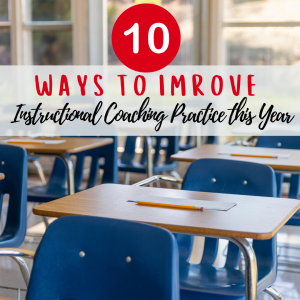10 Ways to Improve Instructional Coaching Practice this Year
Each school year is an opportunity to grow, especially when we improve instructional coaching practice. Being intentional in how we support the growth of teachers is dual benefit- teachers improve their craft causing students to achieve at higher rates.
This post provides 10 ways to improve instructional coaching practice for the school year.
 Pre-Work Phase
Pre-Work Phase
These three steps set the groundwork for the planning phase that comes next. You’ll dig into the current information (data) you have so you can make sound decisions for what to do going forward.
- Evaluate current practices – Look at your current coaching practices and ask yourself:
- What does coaching currently look like at your school?
- What are the teacher support options?
- How effective are these strategies in improving teacher proficiency and student achievement?
- Review teacher performance ratings – Look at the performance rubric scores of each teacher on your roster for next year. Creating a spreadsheet is most helpful by placing each rubric domain across the top, teacher name down the side and fill in ratings in the middle. This allows you to sort data as needed.
- Review student learning outcomes – Look at formal and informal data for students by grade level. Be sure to only use common assessments so you can make an accurate comparison rather than pulling random work samples.
Planning Phase
The following four steps utilize the findings in the pre-work phase to plan and prepare for the new instructional coaching practice plan. They are best completed as an administrative team, but feel free to include instructional coaches as well.
- Set targets – Based on the data collected, set a vision and end goal. This will provide clarity once you start executing your plan. Then establish milestone markers along the way so you can celebrate progress towards the finish line.
- Design teacher support options – There are many ways to support the growth of teachers. Reflecting on what options worked previously, what additional supports could be added? Teachers can benefit from various modes of learning offered. Common learning opportunities are whole or small group professional development, grade level or subject area professional learning communities, 1:1 coaching cycles, and mentor pairings. Knowing teacher and student data allow you to create options that best suit the needs of your school. (Browse instructional coaching materials here to help you plan your teacher support options.)
- Compile coaching techniques – Research current best practices through scholarly articles, national newspaper magazines, and published books. (See a recommended reading list here.) Make note of commonalities and suggested techniques to build into your coaching practice.
- Plan evidence collection intervals – Now that you know where you are going and how you plan to get there, you need to design a plan to collect evidence. Deciding ahead of time what “look for’s” you’ll reference to know whether or not coaching is working ensures effective use of your time and alignment to your goals. Select how often you’ll want to review evidence and make a list of what you plan to collect (ie. student scores, teacher observation data, anecdotal notes, etc.)
Execution Phase
The final phase of 3 steps puts all the pre-work and planning into practice.
- Train instructional coaches – Review the teacher support options coaches can implement to support the growth of teachers and students. Discuss what these options look like in detail and create a system to hold them accountable for implementing the strategies as intended. The best way to do this is through mock practice with feedback. Then coaches can perfect their use of techniques prior to working with teachers. Check out these practice scenarios here.
- Roll out to teachers – Growth requires assistance from all parties. Coaches cannot force teachers to grow. Including teachers in the discussion about the plan for supporting their growth in the coming school year ensures they know all options available to them. Informing them of the accountability measures for growth increases the likelihood that they take advantage of the support options.
- Review and revise – Each quarter or semester, review the instructional coaching program strategy and revise as necessary. You can collect and review evidence prior to these points in time, but try not to make adjustments too quickly. Make revisions slowly and intentionally, allowing the process to work.
By following these 10 steps, you will improve your instructional coaching practice and experience tremendous returns on your investment.
If you are need of resources to help you become an even stronger coach, browse these printable and digital options. Check out my instructional coaching must-haves here. Also, catch up on other help instructional coaching blog posts here.
GO BE GREAT!

What other ways would you add to improve instructional coaching practices at your school?
